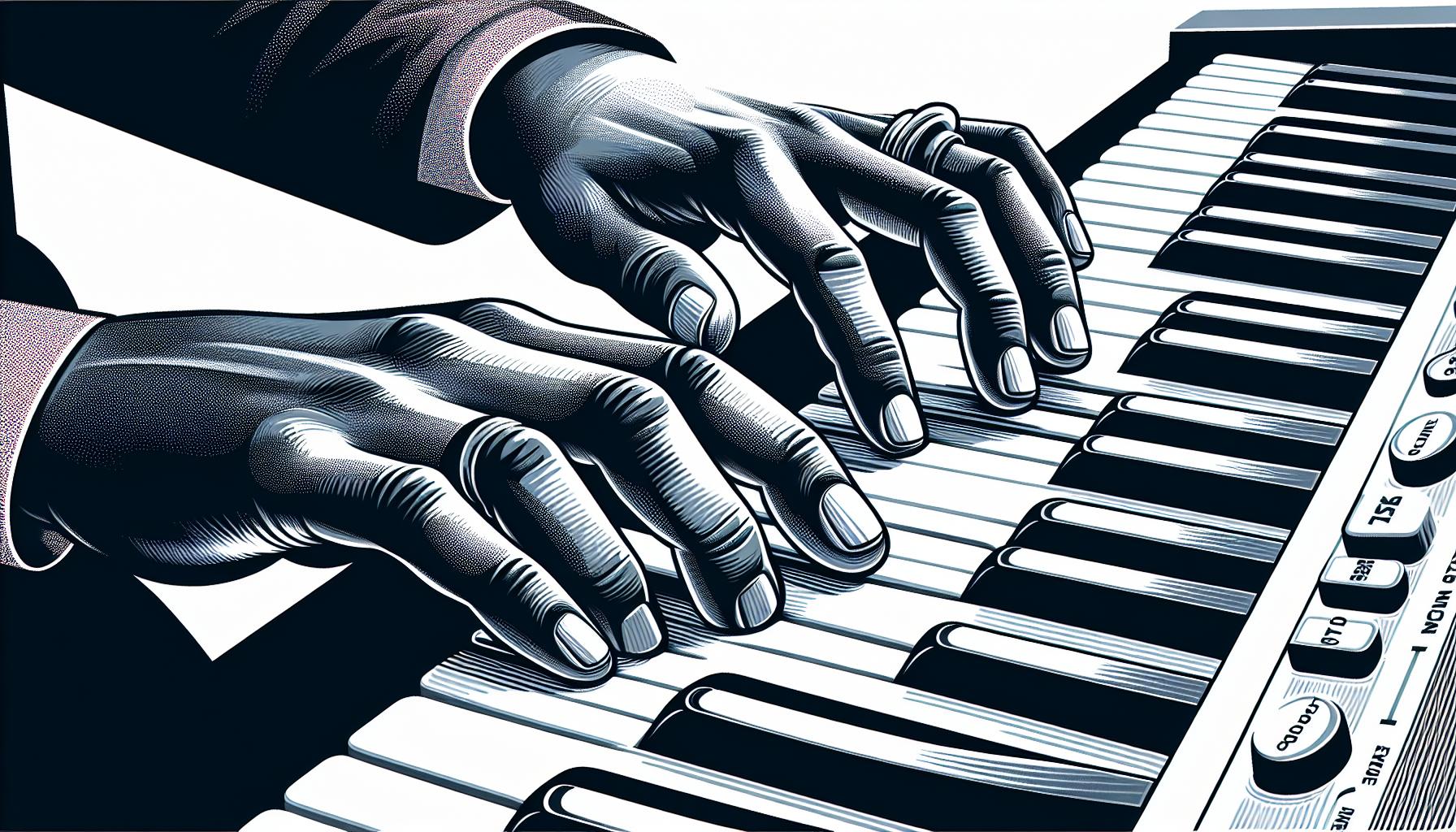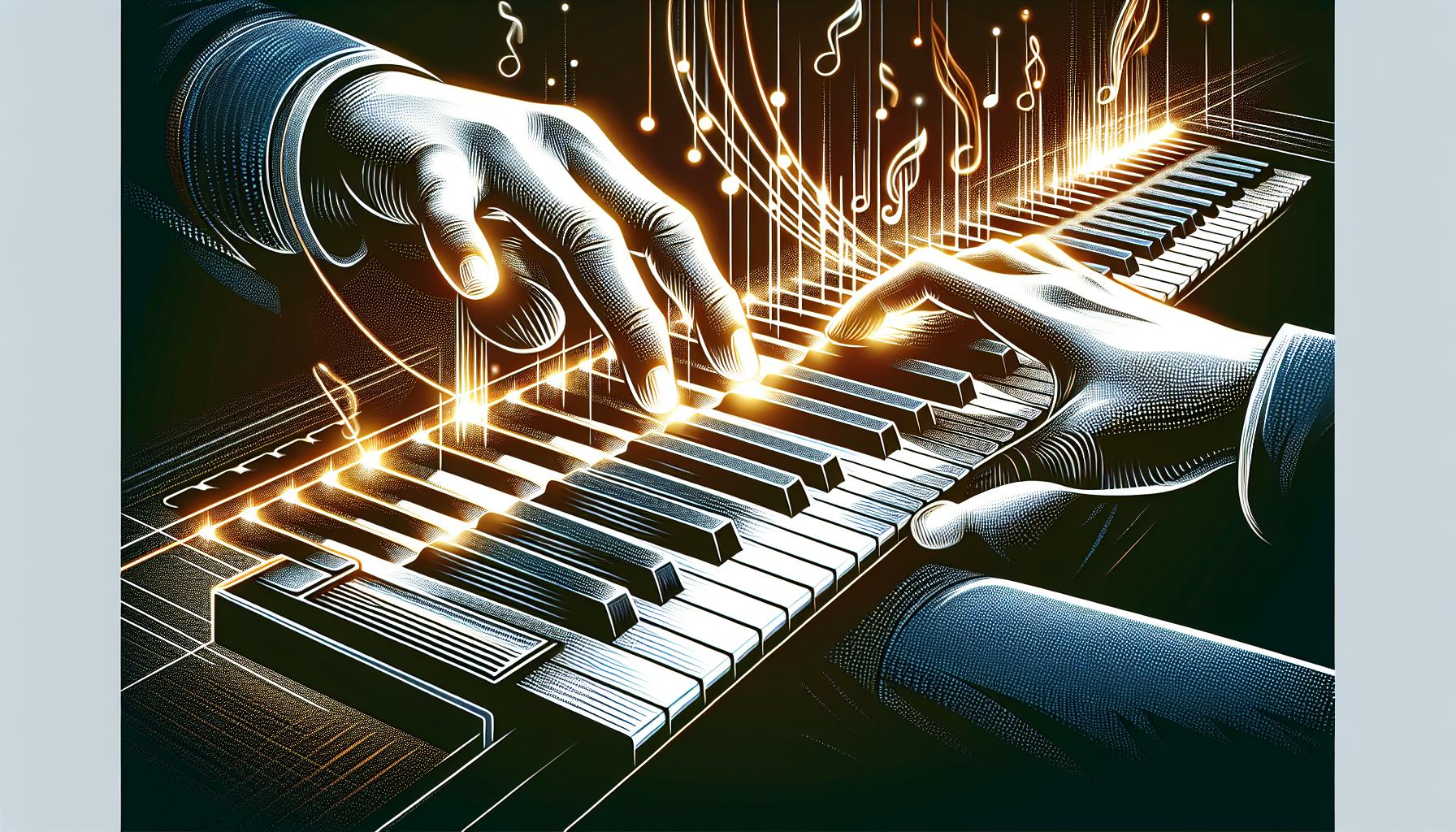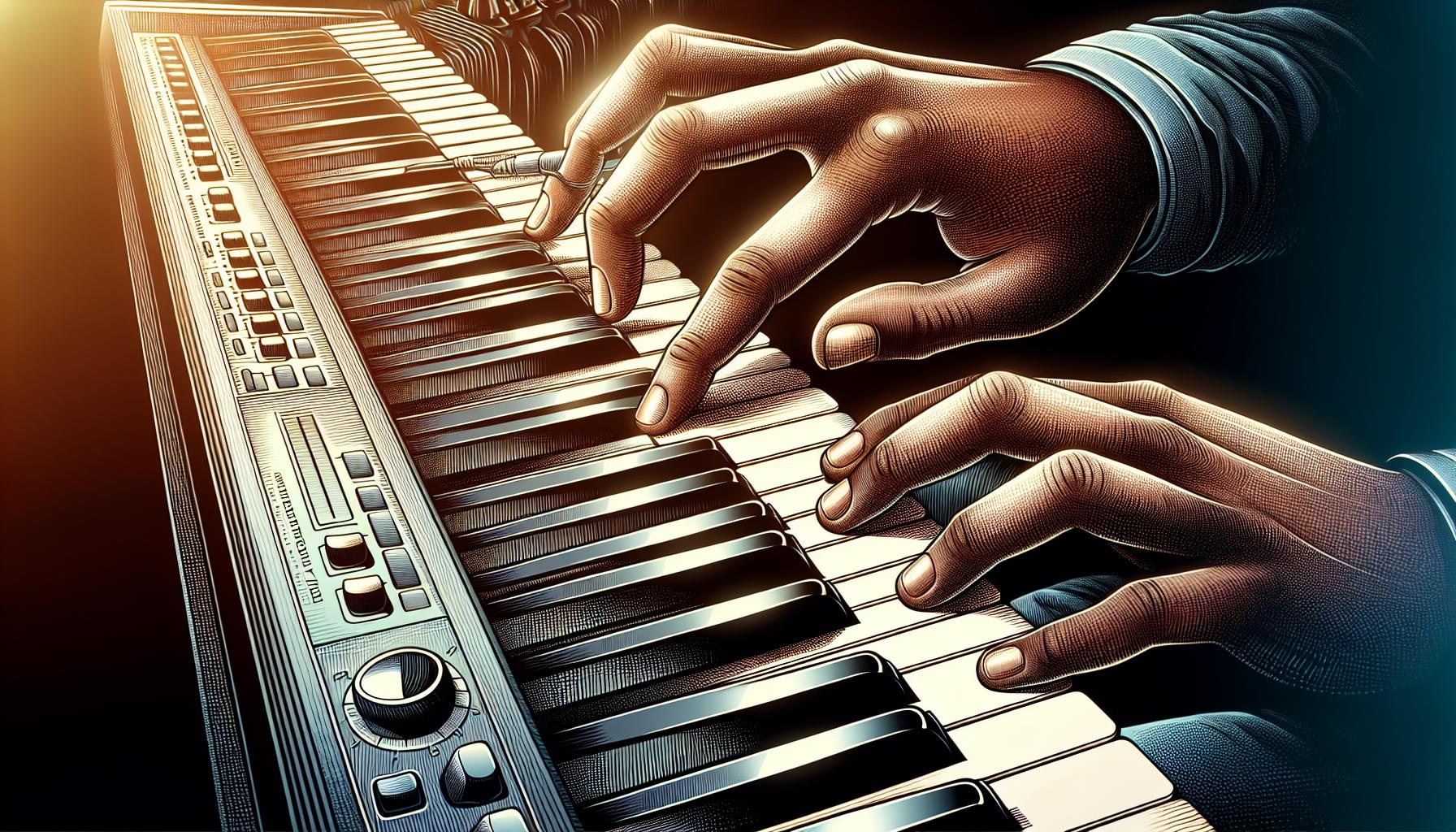Diving into the world of funk music, one can't help but be drawn to the infectious rhythms and soulful grooves that define this genre. At the heart of that irresistible vibe are the funk keyboard grooves, a blend of rhythm and melody that sets your feet tapping and your soul alight. Even for beginners, mastering some easy funk keyboard patterns can open up a new realm of musical expression.
For those eager to channel their inner funk maestro, starting with a few simple grooves can make all the difference. These patterns not only lay the foundation for more complex compositions but also instill a sense of rhythm and timing essential for any budding keyboardist. Let's dive into the world of easy funk keyboard grooves and get those fingers flying across the keys with soul and style.
Exploring Funk Music
The essence of funk music lies in its rhythmic complexity and its ability to make listeners move. This genre, evolving from the late 1960s and early 1970s, brought with it a new era of musical expression, heavily influenced by jazz, soul, and R&B. Central to funk's distinctive sound are the keyboard grooves that lock in with the bass and drums to create an unstoppable force of rhythm.
Funk music is characterized by its emphasis on the downbeat. With a syncopated bassline that often utilizes the "one" (the first beat of each measure), musicians craft grooves that differ markedly from the consistent backbeats of rock and pop. This focus on the downbeat, coupled with intricate rhythms, results in a powerful and dance-inviting sound.
Keyboards, particularly electric pianos and clavinets, play a crucial role in funk compositions. They provide not just melody and harmony but also rhythmic patterns that can make or break a song. A classic example of this is Herbie Hancock's "Chameleon," where the keyboard part is as integral to the groove as the bass and drums.
The Influence of Funk Music
Funk has left an indelible mark on many genres of music. From hip-hop to electronic dance music, elements of funk can be heard far and wide. It's this cross-genre influence that has kept funk alive and well, inspiring a new generation of musicians and music lovers.
- Hip-hop producers have long sampled the breaks from funk records, using these grooves as the backbone for rap tracks.
- In pop music, funky basslines and rhythms can turn a simple song into a hit that's impossible to sit still to.
- Electronic music often borrows the syncopated rhythms and bass-heavy sounds of funk to create danceable tracks.
Starting with Simple Grooves
For those looking to explore funk keyboard playing, starting simple is key. Mastering a few basic grooves can provide a solid foundation on which to build more complex rhythms. Patterns based on the pentatonic scale or the blues scale are especially user-friendly for beginners.
- Focus on keeping the rhythm steady. Even the simplest groove can sound impressive with consistent timing.
- Experiment with different sounds on your keyboard. The clavinet and electric piano presets can instantly give your playing a more authentic funk
The Essence of Funk Keyboard Grooves

Stepping into the world of funk music, one quickly realizes the undeniable sway of keyboard grooves that make your feet move and your heart groove. The essence of funk lies not just in the notes played but in the soulful syncopation and rhythmic interplay between instruments. Funk keyboard grooves, in particular, are a vital element that adds flavor and depth to the music. They bridge the gap between melody and rhythm, creating a seamless flow that is both intoxicating and invigorating.
At the heart of every memorable funk tune is a keyboard groove that stands out for its catchy melody, rhythmic precision, and the ability to make listeners feel every beat. Keyboardists in funk bands often draw inspiration from jazz, soul, and R&B, incorporating elements like swing notes and syncopation to create grooves that are complex yet accessible. This incorporation of diverse influences ensures that funk keyboard grooves have a unique sound that’s both versatile and unmistakably funky.
Crafting the Perfect Groove involves a deep understanding of rhythm and timing. The groove must lock in perfectly with the bass and drums, forming a unified front that lays down the foundation of the song. It’s about playing with the rhythm, sometimes pushing against it, other times laying back to create tension and release. This push and pull are what gives funk its distinctive bounce, inviting the listener to dance along.
Keyboard players often experiment with different sounds to find the perfect tone that complements the groove. Classic funk recordings feature an array of keyboard sounds, from the punchy strikes of a Clavinet to the smooth swirls of an electric piano. Each sound brings a different color to the groove, allowing for a rich tapestry of musical expression. Players might start with a simple riff or chord progression, then layer on effects like wah-wah or phaser to add texture and movement to the sound.
In practice, Funk Keyboard Grooves are about more than just the notes. It’s the attitude, the feel, and the groove that count. Keyboardists looking to master this art should pay close attention to the groove's dynamics, experimenting with volume, articulation, and spacing to see how they affect the overall feel. It’s also important to listen to lots of funk music, absorbing the nuances of iconic tracks and understanding what makes each one tick.
To develop a solid foundation in funk, beginners are encouraged to start with basic rhythms and gradually introduce complexities.
Benefits of Mastering Easy Funk Keyboard Patterns

Mastering easy funk keyboard patterns offers a wealth of benefits for musicians. It not only lays a solid foundation for understanding the funk genre but also immensely improves a player's versatility across multiple musical styles. By focusing on these simpler grooves, musicians can rapidly build their confidence, honing their timing and rhythm in a fun and engaging way.
One of the primary advantages is the development of musical ear and improvisation skills. As players become comfortable with basic patterns, they're better equipped to anticipate changes in the music and react creatively. This spontaneity is a hallmark of funk music, where a sudden shift in groove or an unexpected fill can electrify the atmosphere.
| Skill | Benefit |
|---|---|
| Timing and Rhythm | Improved synchronization with other musicians |
| Musical Ear | Enhanced ability to understand and anticipate musical changes |
| Improvisation Skills | Increased creativity in performances |
Furthermore, mastering these patterns encourages exploration of the keyboard's sonic possibilities. Funk music is known for its innovative use of keyboard sounds, and beginning with easy patterns allows players to experiment with different textures and effects without being overwhelmed. This experimentation is crucial for developing a unique sound that can set a musician apart.
Focusing on easy grooves also fosters musical discipline and work ethics. The repetitive nature of funk patterns, even the simpler ones, requires consistent practice and attention to detail. Musicians learn the value of patience and persistence, qualities that are beneficial in all areas of life.
Playing funk keyboard grooves, especially in a group setting, also enhances collaboration skills. Funk music is inherently communal, relying on the tight interplay between instruments to create its signature sound. Musicians adept at easy funk patterns contribute more effectively to a group, listening closely to their bandmates, and responding dynamically to the music around them.
Additionally, as musicians gain proficiency in these patterns, they naturally find their practice sessions more enjoyable. The playful and rhythmic nature of funk music turns practice into an exciting exploration rather than a chore. This joy in practice promotes a lifelong love for playing music, encouraging continuous learning and growth.
Getting Started with Simple Grooves

When first venturing into the vibrant world of funk keyboard playing, starting with basic grooves is the key to rapidly building confidence and skill. These simple patterns are the backbone of funk music, creating a solid foundation upon which budding musicians can expand their repertoire. To kick off this journey, focusing on rhythms and the unique syncopation that defines funk is a great starting point.
A good rule of thumb for beginners is to keep it simple. Starting with one or two chord grooves allows for practicing the rhythmic complexity of funk without being overwhelmed by complicated chord progressions. This approach makes it easier to feel the groove and focus on the timing, which is crucial in funk music.
Incorporating Octaves and Basic Chords
The use of octaves is a common feature in funk keyboard patterns. Playing the same note in different octaves can add depth and excitement to a groove. Beginners should practice shifting octaves while maintaining rhythm to add a dynamic layer to their sound. Basic chords, such as sevenths and ninths, also play a significant role in funk music. These chords add a distinct color and mood to the music, characteristic of the funk genre.
Practice Techniques
To truly master simple grooves, integrating specific practice techniques is beneficial:
- Metronome Use: Practicing with a metronome improves timing, a critical component in funk music. It helps musicians lock in the groove and stay on beat.
- Listening and Imitation: Listening to classic funk tracks and attempting to play along can accelerate learning. This technique helps in understanding groove placement and the genre’s stylistic nuances.
- Slow Practice: Playing patterns slowly at first, then gradually increasing the speed, ensures accuracy and a deeper musical understanding.
- Recording and Critique: Recording practice sessions and critically listening back can uncover areas for improvement that might not be obvious in the moment.
By incorporating these techniques, beginners can make significant progress in their ability to play funk keyboard grooves.
Exploring Keyboard Sounds
Funk music is known for its rich palette of sounds, from the classic clavinet to electric pianos and synthesizers. Experimenting with different keyboard sounds can greatly enhance the funk experience, bringing grooves to life in unique ways. Beginners should take time to explore and understand the settings on their keyboards or software that emulate these iconic sounds.
Elevating Your Funk Keyboard Game

Once you've dipped your toes into the funk keyboard waters by mastering simple grooves, it's time to take things up a notch. Elevating your funk keyboard game involves adding complexity and flair to your playing style. Here's how you can begin to expand your skills and make those grooves even funkier.
Experiment With Advanced Chords
To truly capture the essence of funk, you'll need to go beyond basic seventh and ninth chords. Funk music often utilizes extended and altered chords to achieve its characteristic sound. Start experimenting with eleventh and thirteenth chords, as well as altered dominants like sharp nines or flat fives. These chords can add a new layer of richness and color to your playing.
| Chord Type | Characteristic |
|---|---|
| Seventh | Basic funk staple |
| Ninth | Adds depth |
| Eleventh | Introduces complexity |
| Thirteenth | Adds richness |
| Altered Dominants | Creates tension |
Master the Art of Syncopation and Timing
Rhythm plays a pivotal role in funk music; it’s what gives it that distinctive "groove." As you progress, focus on mastering more complex rhythms and syncopations. Playing off the beat, or adding unexpected accents, can significantly enhance the feel of your grooves. Use a metronome to practice these rhythms slowly, gradually increasing the tempo as you become more comfortable.
Incorporate Slides and Grace Notes
To add expressiveness to your playing, start incorporating slides and grace notes into your grooves. These techniques can make your playing sound more fluid and natural. A slide, or glissando, involves moving from one note to another smoothly, which can be particularly effective in funk music for transition between chords or embellishing a groove. Grace notes, on the other hand, are quick, almost percussive notes played just before a main note, adding texture and rhythm to your playing.
Explore the World of Riffs and Hooks
Riffs and hooks are memorable phrases of music that can really make a funk groove stand out. They are often what people will remember most about a piece. Start creating your own riffs and hooks by playing around with short phrases and motifs. Mixing these into your grooves can add an element of surprise and keep listeners engaged.
Conclusion
Diving into the world of funk keyboard grooves opens up a playground of musical expression. By adding advanced chords, mastering syncopation, and experimenting with slides and grace notes, players can truly bring their music to life. Remember, it's not just about the notes you play but how you play them. Exploring riffs and hooks further enriches your sound, making each performance uniquely yours. So keep pushing the boundaries and let your funk keyboard journey continue to evolve. Your audience is ready to groove along with you.
Harlan Kilstein began playing piano during covid with no piano background at all. He taught himself how to play learning what to do and what not to do.
Today he's an advanced intermediate player and can help you grow in your skills because he learned all this on his own.








